Exercises (3201)
Mobilisation: Spine
Mobilisation of the joints / dynamic stretching
Individual work
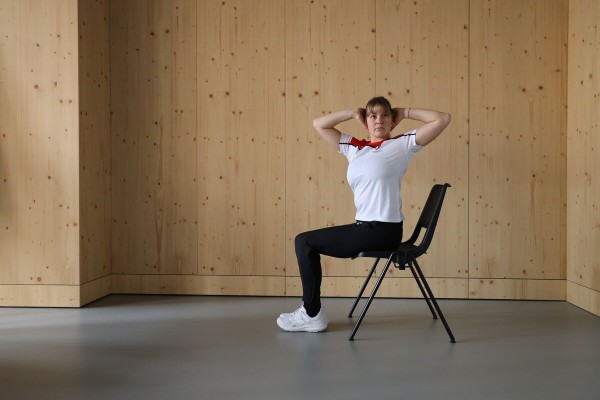
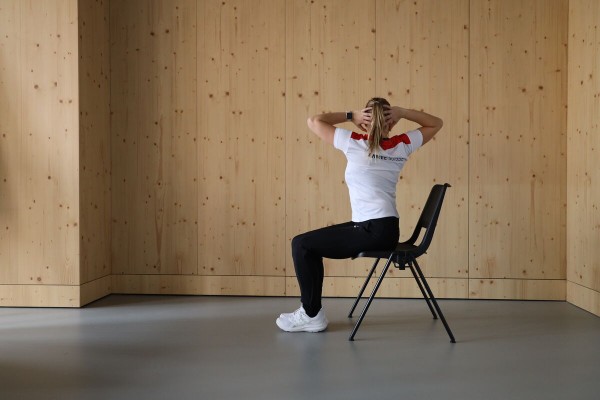
Sitting on a chair with your back straight, cross your arms behind your head. From this position, slowly rotate your upper body from side to side (looking to the left and right respectively).
1 (office) chair
Mobilisation: Spine
Mobilisation of the joints / dynamic stretching
Individual work









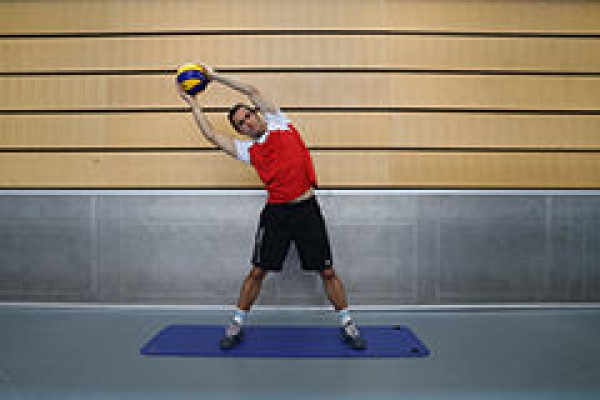
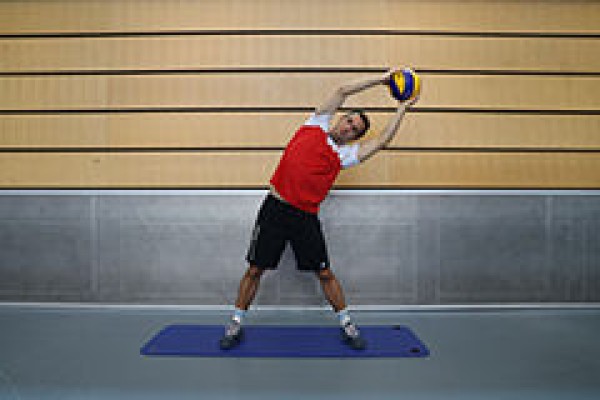
Legs straddled wide in an upright position, outstretched arms held high (overhead), grasp the aid with both hands. Tilt/move the upper body alternately from one side to the other.
Variant:
Exercise can also be performed in a hip-width stance or kneeling position.
Per Tn:
1 ball ►baseball, blitzball/rugby/football, fistball, futsal/football, handball, FooBaSKILL, volleyball
1 stick ► floorball, intercrosse/lacrosse, Nordic walking
1 racket ►badminton/speedminton, smolball
1 throwing disc (frisbee) ►frisbee ultimate
1 elasticated rubber band/power tube/skipping rope/playing rope
1 gymnastics stick with elastic band
Mobilisation: Spine
Mobilisation of the joints / dynamic stretching
Individual work
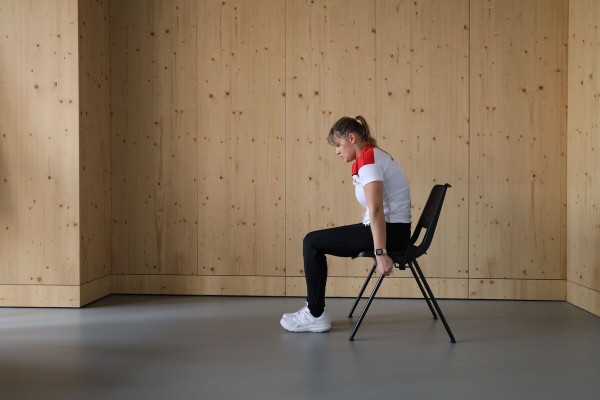
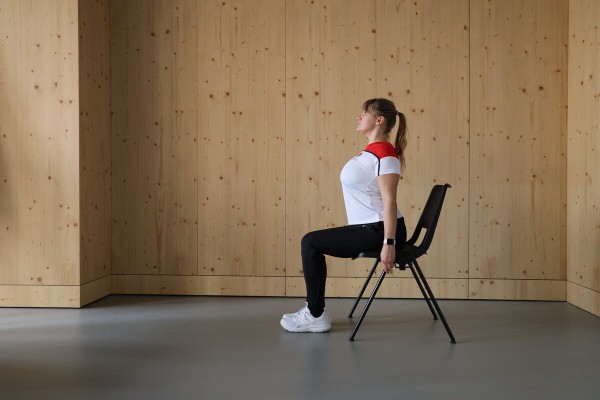
While sitting upright, grip the seat of the chair on each side with your hands. Alternate between a position with a rounded back ("cat hump") and a position with a hollow back ("cow"). Perform the movement slowly and in a controlled manner until the end of each reach.
Cat: Exhale, draw in your belly button, tilt your pelvis backwards, bend your spine upwards, pull your chin towards your chest and push your arms firmly against the seat.
Cow: Inhale, press your belly button towards the floor, tilt your pelvis forwards, your spine is bent towards the floor and your chin is pointing diagonally forwards (stretch your head, tilt backwards), your shoulder blades are pulled together and your arms push firmly against the seat.
1 (office) chair
Mobilisation: spine / shoulders
Mobilisation of the joints / dynamic stretching
Individual work


Legs straddled wide, upper body leaning far forwards. In the swing, alternately bring each hand crosswise to the tip of the foot, with the other hand pointing upwards at the back.
No material required
Mobilisation: spine / shoulders
Mobilisation of the joints / dynamic stretching
Partner work

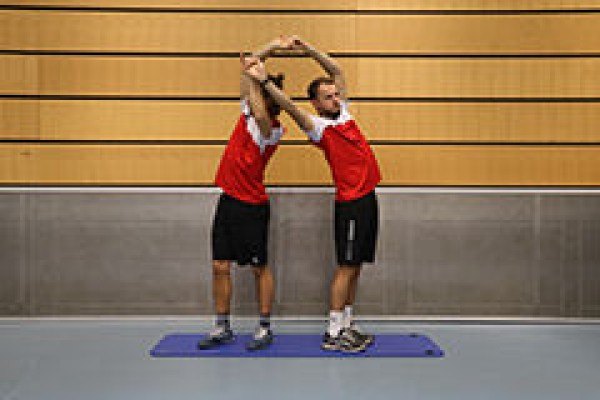

Frontal facing of the partners with mutual grasping of hands. The arms are raised above the heads and the two participants rotate once around their own axis without letting go of each other's hands. The direction of rotation is changed after each execution.
No material required
Mobilisation: spine / shoulders
Mobilisation of the joints / dynamic stretching
Individual work







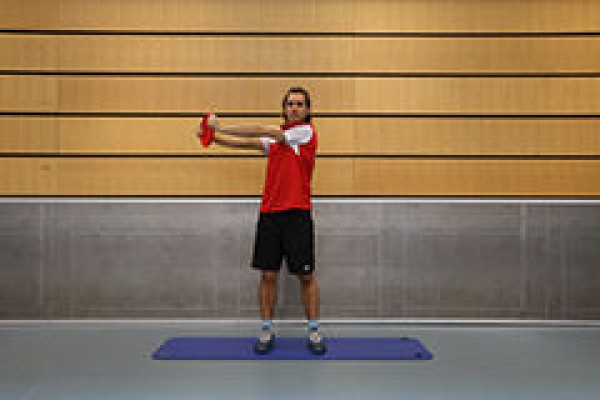


Stand with your arms outstretched in front of you and grasp the aid with both hands. Move/swing your arms from one side to the other at chest height with the largest possible range of motion (arms pointing diagonally backwards).
Variant:
Exercise can also be performed in a kneeling position.
Per Tn:
1 ball ►baseball, blitzball/rugby/football, fistball, futsal/football, handball, FooBaSKILL, volleyball
1 stick ► floorball, intercrosse/lacrosse, Nordic walking
1 racket ►badminton/speedminton, smolball
1 throwing disc (frisbee) ►frisbee ultimate
1 elasticated rubber band/power tube/skipping rope/playing rope
1 gymnastics stick with elastic band
Mobilisation: spine / shoulders
Mobilisation of the joints / dynamic stretching
Individual work


Stand with your arms outstretched in front of you (grasp hands if necessary). Move/swing your arms from one side to the other at chest height with as wide a range of motion as possible (arms pointing diagonally backwards).
Variant:
Exercise can also be performed in a kneeling position.
No material required
Mobilisation: spine / shoulders
Mobilisation of the joints / dynamic stretching
Partner work

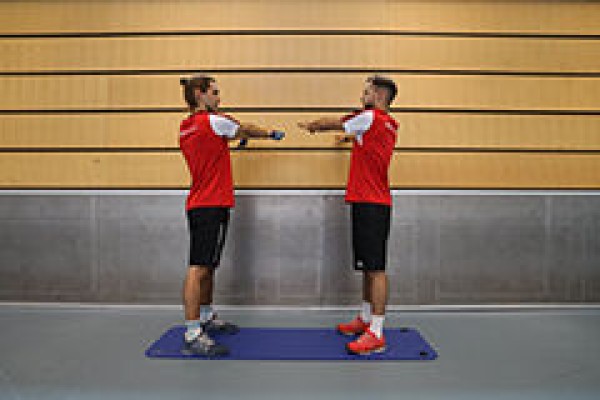









The partners stand hip-width apart with their arms outstretched in front of them. Together, the aid is held slightly less than shoulder-width apart at chest height and moved/swung from one side to the other with the greatest possible range of motion (arms pointing diagonally backwards).
Variant:
The exercise can also be performed in a kneeling position.
Per group of 2:
1 ball ►baseball, blitzball/rugby/football, fistball, futsal/football, handball, FooBaSKILL, volleyball
1 stick ► floorball, intercrosse/lacrosse, Nordic walking
1 racket ►badminton/speedminton, smolball
1 throwing disc (frisbee) ►frisbee ultimate
1 elasticated rubber band/power tube/skipping rope/playing rope
1 gymnastics stick with elastic band
Carrot pulling
Fighting and roughhousing games
Group work
6-10 participants
The participants lie on their stomachs, form a circle and hold hands (or interlock arms). Depending on the size of the group, two to four "farmers" are nominated who now have to grab as many of the participants lying on the floor (carrots) by the feet and pull them out of the circle (time limit may apply). If they succeed in doing this with one of the participants, this person automatically becomes a "farmer". The aim is to have harvested all the "carrots" at the end.
No material required
Music cards
Stimulate circulation
Group work
Each participant receives a card with a task and moves freely in the hall/area to the music (study the exercise). The sports leader can specify various forms of movement (crossing legs, circling arms, crouching, touching the floor, hopping, hopping with one leg, etc.). As soon as the music becomes quieter, the card must be placed on the floor and the exercise performed according to the instructions. As soon as the music gets louder again, the participants look for a new card, move freely around the hall/area again and study the next task.
Variant:
This form of the game can be used to form teams by depicting coloured symbols or numbers on the task cards (see sample) and the participants form the teams based on their last task card.
1 music system incl. music (various)
x task cards
Music stop
Stimulate circulation
Group work
Each participant moves freely in the hall/area to the music. The sports leader can specify various forms of movement (crossing legs, circling arms, crouching, touching the floor, hopping, hopping with one leg, etc.). When the music stops, the participants complete a task announced by the sports leader as quickly as possible (until the music starts again):
- 5 jumping jacks
- 4x two-legged jumps over a line
- Greeting a partner in a push-up position
- Touching the top rung of the wall bars
- etc.
1 music system incl. music (various)
Move your arms upwards while standing
Power
Individual work



Standing upright, hold two dumbbells at the side of your body with your arms hanging down, grasp the dumbbells with an underhand grip (palms facing forwards), raise your practically straight arms upwards in a circular motion so that your almost closed arms are pointing diagonally upwards in front of your head (first raise the dumbbells sideways before bringing your arms together slightly above head height at about shoulder height). While raising the dumbbells, turn your arms in so that the backs of your hands are pointing upwards in the end position. Then move your arms back to the starting position in the reverse sequence of movements.
Attention:
Keep your shoulders lowered and your back straight; always keep your arms under tension (do not let them hang completely or bring them fully together).
Lighten:
Without/less weight.
Harden:
More weight or additional weight (on the arms).
2 dumbbells
2 weight cuffs ► Make the exercise more difficult (additional weight)
Move the arms forwards and backwards in a prone position ► W-extension / W-raise / W-Y-extension
Power
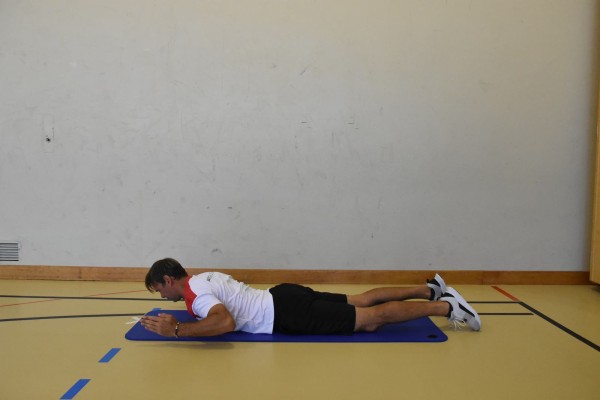

Lying on your stomach with your upper body slightly raised, feet shoulder-width apart, arms bent beside your body (hands at head height - palms facing inwards or downwards - W position), stretch your arms out diagonally forwards as an extension of your body and bend them back to the starting position.
Attention:
Do not lower your upper body and arms completely.
Lighten:
Lower your upper body/arms after each repetition or every now and then.
Harden:
Additional weight on the arms/in the hands.
Note:
The position of the hands is important for the target muscles and the position of the joints.
Palms facing down (pronated grip) = muscle activation: emphasizes the upper trapezius and the external rotators of the shoulder (e.g., infraspinatus, teres minor) / shoulder position: shoulders are more externally rotated / advantage: good posture correction, strengthens the back of the shoulders / disadvantage: can be uncomfortable or restrictive if you have shoulder problems.
Palms facing each other (neutral grip) = muscle activation: activates the middle trapezius, rhomboids, and rear deltoid muscles more strongly / shoulder position: less external rotation, easier on the joints / advantage: often more comfortable for the shoulder joints, better control / disadvantage: less targeted external rotation if that is the goal.
When to choose which: Shoulder health/rehab = neutral (palms facing each other)/focus on external rotators = pronated (palms facing down)/improve posture = both options are useful/keep movement pain-free = neutral is preferable.
Conclusion: The hand position during the W extension influences which parts of the shoulder muscles are used more and how stressful the movement is for the shoulder joints. Both variants are useful – depending on the goal or how it feels, both can be used (or even alternated during training).
Variation I:
Alternately raise one arm (instead of both at the same time).
Variation II:
Position on a flat bench or an incline bench.
2 weight cuffs/weight balls/dumbbells ► Make the exercise more difficult (additional weight)
Move the arms forwards and backwards in a prone position ► W-extension / W-raise / W-Y-extension
Power
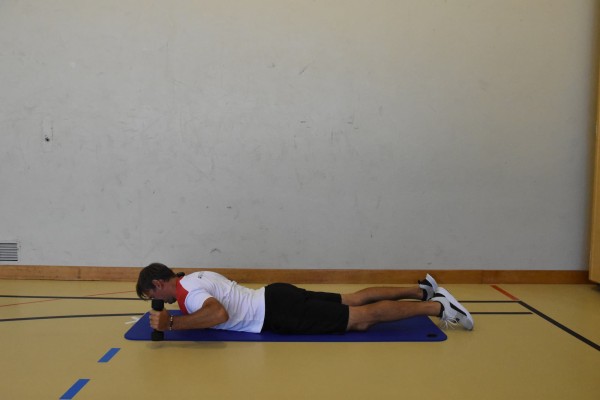
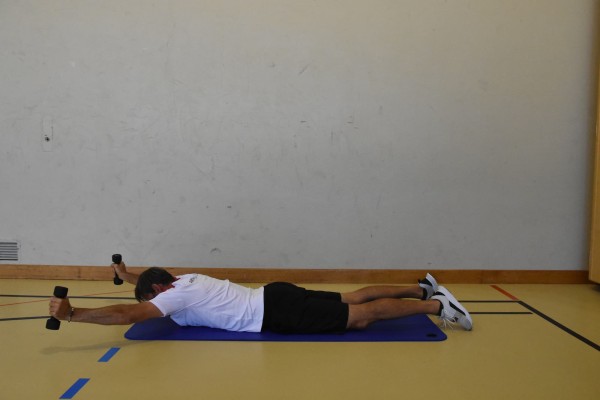
Lying on your stomach with your upper body slightly raised, feet shoulder-width apart, arms bent beside your body (hands at head height - palms facing inwards or downwards - W position), hold a (light) dumbbell in each hand, stretch your arms out diagonally forwards as an extension of your body and bend them back to the starting position.
Attention:
Do not lower your upper body and arms completely.
Lighten:
Lower your upper body/arms after each repetition or every now and then.
Harden:
Additional weight on the arms/in the hands.
Note:
The position of the hands is important for the target muscles and the position of the joints.
Palms facing down (pronated grip) = muscle activation: emphasizes the upper trapezius and the external rotators of the shoulder (e.g., infraspinatus, teres minor) / shoulder position: shoulders are more externally rotated / advantage: good posture correction, strengthens the back of the shoulders / disadvantage: can be uncomfortable or restrictive if you have shoulder problems.
Palms facing each other (neutral grip) = muscle activation: activates the middle trapezius, rhomboids, and rear deltoid muscles more strongly / shoulder position: less external rotation, easier on the joints / advantage: often more comfortable for the shoulder joints, better control / disadvantage: less targeted external rotation if that is the goal.
When to choose which: Shoulder health/rehab = neutral (palms facing each other)/focus on external rotators = pronated (palms facing down)/improve posture = both options are useful/keep movement pain-free = neutral is preferable.
Conclusion: The hand position during the W extension influences which parts of the shoulder muscles are used more and how stressful the movement is for the shoulder joints. Both variants are useful – depending on the goal or how it feels, both can be used (or even alternated during training).
Variation I:
Alternately raise one arm (instead of both at the same time).
Variation II:
Position on a flat bench or an incline bench.
2 weight cuffs/weight balls/dumbbells
Move the arms forwards and backwards in a prone position ► W-extension / W-raise / W-Y-extension
Power
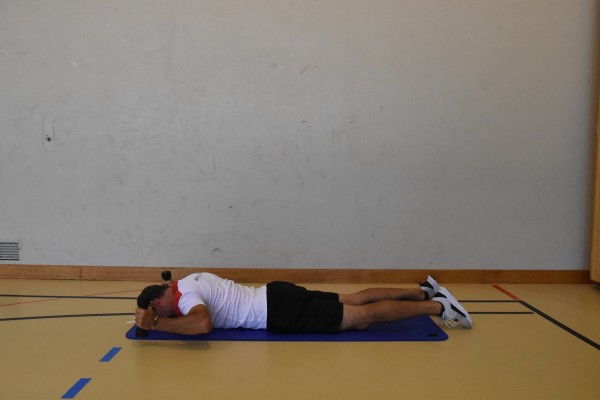
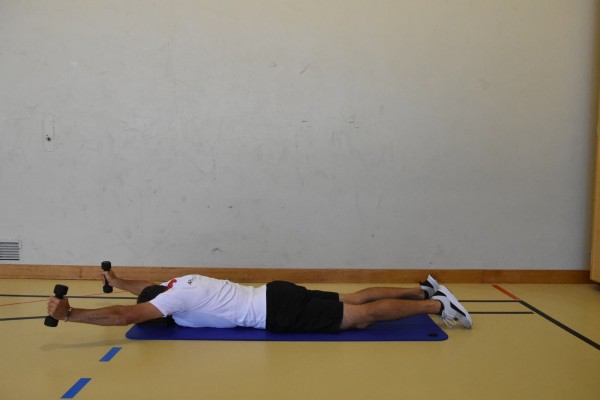
Lying on your stomach with your forehead resting on a folded cloth, feet shoulder-width apart, arms bent beside your body (hands at head height - palms facing inwards or downwards - W position), hold a (light) dumbbell in each hand, stretch your arms out diagonally forwards as an extension of your body and bend them back to the starting position.
Attention:
Do not lower your upper body and arms completely.
Lighten:
Lower your upper body/arms after each repetition or every now and then.
Harden:
Additional weight on the arms/in the hands.
Note:
The position of the hands is important for the target muscles and the position of the joints.
Palms facing down (pronated grip) = muscle activation: emphasizes the upper trapezius and the external rotators of the shoulder (e.g., infraspinatus, teres minor) / shoulder position: shoulders are more externally rotated / advantage: good posture correction, strengthens the back of the shoulders / disadvantage: can be uncomfortable or restrictive if you have shoulder problems.
Palms facing each other (neutral grip) = muscle activation: activates the middle trapezius, rhomboids, and rear deltoid muscles more strongly / shoulder position: less external rotation, easier on the joints / advantage: often more comfortable for the shoulder joints, better control / disadvantage: less targeted external rotation if that is the goal.
When to choose which: Shoulder health/rehab = neutral (palms facing each other)/focus on external rotators = pronated (palms facing down)/improve posture = both options are useful/keep movement pain-free = neutral is preferable.
Conclusion: The hand position during the W extension influences which parts of the shoulder muscles are used more and how stressful the movement is for the shoulder joints. Both variants are useful – depending on the goal or how it feels, both can be used (or even alternated during training).
Variation I:
Alternately raise one arm (instead of both at the same time).
Variation II:
Position on a flat bench or an incline bench.
2 weight cuffs/weight balls/dumbbells
Move the arms forwards and backwards in a prone position ► W-extension / W-raise / W-Y-extension
Power
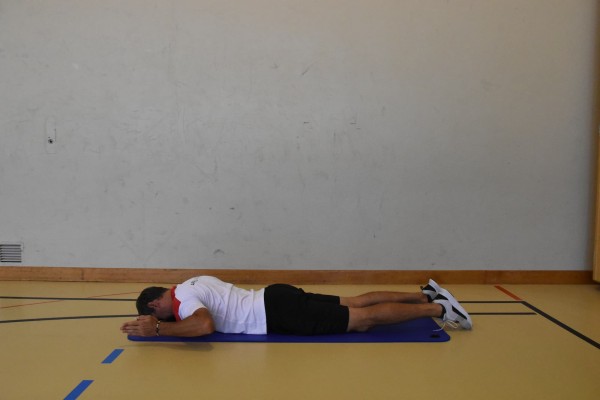
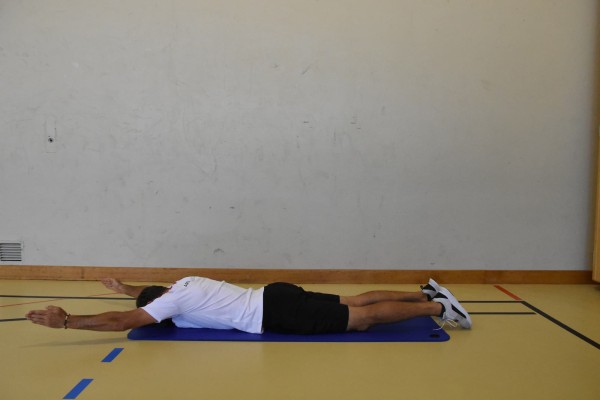
Lying on your stomach with your forehead resting on a folded cloth, feet shoulder-width apart, arms bent beside your body (hands at head height - palms facing inwards or downwards - W position), stretch your arms out diagonally forwards as an extension of your body and bend them back to the starting position.
Attention:
Do not lower your upper body and arms completely.
Lighten:
Lower your upper body/arms after each repetition or every now and then.
Harden:
Additional weight on the arms/in the hands.
Note:
The position of the hands is important for the target muscles and the position of the joints.
Palms facing down (pronated grip) = muscle activation: emphasizes the upper trapezius and the external rotators of the shoulder (e.g., infraspinatus, teres minor) / shoulder position: shoulders are more externally rotated / advantage: good posture correction, strengthens the back of the shoulders / disadvantage: can be uncomfortable or restrictive if you have shoulder problems.
Palms facing each other (neutral grip) = muscle activation: activates the middle trapezius, rhomboids, and rear deltoid muscles more strongly / shoulder position: less external rotation, easier on the joints / advantage: often more comfortable for the shoulder joints, better control / disadvantage: less targeted external rotation if that is the goal.
When to choose which: Shoulder health/rehab = neutral (palms facing each other)/focus on external rotators = pronated (palms facing down)/improve posture = both options are useful/keep movement pain-free = neutral is preferable.
Conclusion: The hand position during the W extension influences which parts of the shoulder muscles are used more and how stressful the movement is for the shoulder joints. Both variants are useful – depending on the goal or how it feels, both can be used (or even alternated during training).
Variation I:
Alternately raise one arm (instead of both at the same time).
Variation II:
Position on a flat bench or an incline bench.
2 weight cuffs/weight balls/dumbbells ► Make the exercise more difficult (additional weight)
Nordic Walking
Running training
Together in a group or individually
In a group or as an individual runner, a route defined by the sports leader is completed.
- Intensity level: 1-2
- Heart rate: 60-80%
- Speech rule: sing - chat
Variant:
The sports leader can specify the form of movement for certain sections of the route (e.g. marked with fanjons/trass tape).The sports director can specify the form of movement for certain sections of the course (e.g. marked with fanjons/tracing tape) (from fanjon 1: double pole, 2: diagonal stride, 3: hop run, 4: relaxed running stride).
Participant:
1 pair of Nordic walking poles
Fanjons/tracing tape ►Variant
Nordic Walking (aktive Regeneration)
Regeneration
Together in the group
Active recovery is better than lying on the couch and doing nothing. However, it should be moderate exercise, i.e. easy cycling, jogging or Nordic walking in a more leisurely form.
In the group, a route defined by the sports leader is completed at a moderate pace.
- Intensity level: 1
- Heart rate: 60-70%
- Rule of thumb: Singing
Participant:
1 pair of Nordic walking poles
Number run
Orienteering
Single run or 2/3 groups
In the terrain, the sports director distributes posts in advance, which the participants then run to individually or in small groups during the numbered run. For this purpose, the participants receive a control overview and a running map. All even or odd-numbered controls are run according to the 1st marked control. Depending on the time available, the 3-person rule could also be an option. The numbered run is carried out as a form of exercise, as the different running routes vary. In this variant, the participants can be sent on the course without staggering, as they do not start in the same direction. The control overview with the running map is handed out together with the start signal. For the numbered run, each participant/group has a defined amount of time to find as many or all of the controls as possible. Under certain circumstances, several runs can also be carried out (e.g. even and odd controls).
Variant I:
Prepare the control transfer point: The participants do not receive a map on which the controls are already marked, but must mark the controls themselves at a control transfer point (e.g. using coordinates, azimuth or measuring point method). The control sheets remain at the start even after the transfer. Before the participants set off on the course, the sports director checks the marked controls.
Orienteering controls (to be unplugged)
1 stopwatch
Participant/group:
1 orienteering map with control overview incl. designation (prepared in advance by the sports director)
1 running map form 30.063
1 bussole
Variation of the exercise:
Participant/group:
1 control transfer sheet
1 map scale
1 pencil and eraser
Number run
Basic training
Group work
Groups of 4 (possibly integrate new group formation)
Form groups of four and number the participants within the group. The participants run behind each other in single file with a certain distance between them and at a normal basic pace (number one at the very back, number four at the very front). Number one catches up with number two, then number two catches up with number three, before number three catches up with number four. The number four now runs back to the number one before catching up and replacing the person in front starts all over again. According to the time specified by the sports director, the participants continue to move at the basic pace and the respective pace changes without interruption.
Variant I:
Change the distance of the participants.
Variant II:
Change the basic pace.
Variant III:
Change the group size (3-8 participants).
Variant IV:
The number one picks up the number two. The pair catches up with number three together, number three now takes over from number one, etc.
Intensity level: 3 (medium)
HFmax: 80-90%
Speaking rule: speak in complete sentences
Note: the exercise form is suitable for tempo and intensity changes
No material required
Number run
Basic training
Group work
Groups of 4 (possibly integrate new group formation)
Form groups of four and number the participants within the group. The participants run behind each other in single file at a certain distance and at a normal basic pace (number four at the very back, number one at the very front). Number four overtakes all the other participants and continues to run at a faster pace until the distance to the person behind (number one) is approximately the same as the distance between the other runners. The number three then starts to overtake the runners in front (possibly with a shout from the new leader). According to the time set by the sports leader, the participants continue to move at the basic pace and the respective pace changes without interruption.
Variant I:
Change the distance of the participants.
Variant II:
Change the basic pace.
Variant III:
Change the group size (3-8 participants).
Intensity level: 3 (medium)
HFmax: 80-90%
Speaking rule: speak in complete sentences
No material required
Number race
Increase pulse
Group work
4-6 participants per group
All participants in a group are given a number and line up in a column behind the starting marker. On an acoustic signal (e.g. a number called out by the sports leader, number of beats on the tambourine or tapping with sticks), the runners matching the sound (same numbers) compete against each other by running round a turnaround and returning to the starting position. The winning group receives a point (points may be awarded to the winner as well as the second and third place finishers). After a certain number of rounds, the groups are reshuffled so that the same participants do not always compete against each other.
Variant:
Change the form of movement (e.g. one-legged hopping, four-footed gait, running backwards).
Per group:
2 colouring sticks
Depending on signal selection:
1 tambourine
2 drumsticks
Number race in a circle
Increase pulse
Group work
10-20 participants per group
Choops are distributed in a circle in the hall/area (even number and labelled with number sheets) so that one participant can stand in each hoop (number of participants = number of hoops). The two teams line up opposite each other. The tyres opposite each other are given the same number (for two teams). When an acoustic signal is given (e.g. a number is called out by the sports leader, the number of beats on the tambourine or tapping with sticks), the participants with the same number compete against each other. The first person to take the opponent's position wins the round and collects a point for their team. The game leader can decide whether the run has to go through the circle or around the circle (possibly changing the form of locomotion, e.g. one-legged hopping, four-footed gait, running backwards). After a certain number of rounds, the positions within the team are swapped so that the same participants do not always compete against each other. Which team collects more points?
Variant:
Individual competition. Each participant counts the rounds they have won. The positions must be swapped as often as possible (e.g. after each duel, one side swaps positions with its left neighbour and the other with its right neighbour) so that there are many different duels. The disadvantage of this form is that not all participants complete the same number of runs.
Per participant:
1 hoop
x number sheets
Depending on signal selection:
1 tambourine
2 drumsticks
Move upper leg forwards in lateral forearm support (left) ► knee raise lateral pillar bridge / side bridge
Power
Individual work

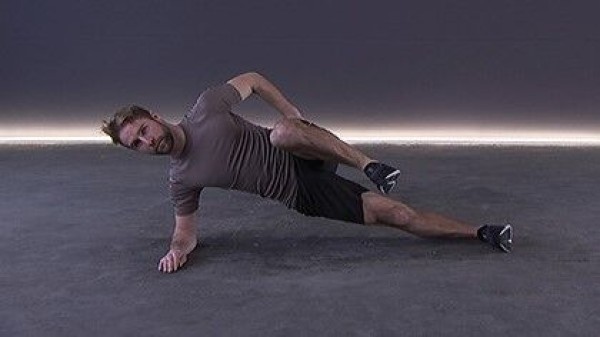
Side support on the (left) forearm, push the thigh of the upper leg straight out forwards (lower leg parallel, thigh bent at approx. 90 degrees to the body/leg) and return to the starting position.
Attention:
Head, torso, hips and knees practically form a line (pelvis does not tilt backwards or forwards), keep the shoulder above the elbow.
Lighten:
Knee on the floor; move your leg less forwards; just hold the position.
Harden:
Additional weight (for the free leg or on the hip); unstable support (possible for both the arm and the leg).
1 weight cuff/weight vest/weight disc/sandbag ► making the exercise more difficult (additional weight)
1 ball/1-2 balance cushions/1 balance board ► making the exercise more difficult (unstable surface)
Move upper leg forwards in lateral forearm support (right) ► knee raise lateral pillar bridge / side bridge
Power
Individual work


Side support on the (right) forearm, push the thigh of the upper leg straight out forwards (lower leg parallel, thigh bent at approx. 90 degrees to the body/leg) and return to the starting position.
Attention:
Head, torso, hips and knees practically form a line (pelvis does not tilt backwards or forwards), keep the shoulder above the elbow.
Lighten:
Knee on the floor; move your leg less forwards; just hold the position.
Harden:
Additional weight (for the free leg or on the hip); unstable support (possible for both the arm and the leg).
1 weight cuff/weight vest/weight disc/sandbag ► making the exercise more difficult (additional weight)
1 ball/1-2 balance cushions/1 balance board ► making the exercise more difficult (unstable surface)